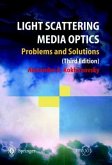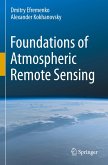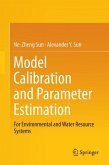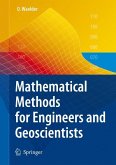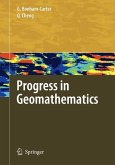Handbook of Geomathematics
Herausgegeben:Freeden, Willi; Nashed, M. Zuhair; Sonar, Thomas
Handbook of Geomathematics
Herausgegeben:Freeden, Willi; Nashed, M. Zuhair; Sonar, Thomas
- Gebundenes Buch
- Merkliste
- Auf die Merkliste
- Bewerten Bewerten
- Teilen
- Produkt teilen
- Produkterinnerung
- Produkterinnerung
During the last three decades geosciences and geo-engineering were influenced by two essential scenarios: First, the technological progress has changed completely the observational and measurement techniques. Modern high speed computers and satellite based techniques are entering more and more all geodisciplines. Second, there is a growing public concern about the future of our planet, its climate, its environment and about an expected shortage of natural resources. Obviously, both aspects, viz. efficient strategies of protection against threats of a changing Earth and the exceptional…mehr
Andere Kunden interessierten sich auch für
![Light Scattering Media Optics Light Scattering Media Optics]() Alexander A. KokhanovskyLight Scattering Media Optics114,99 €
Alexander A. KokhanovskyLight Scattering Media Optics114,99 €![Imaging Convection and Magnetism in the Sun Imaging Convection and Magnetism in the Sun]() Shravan HanasogeImaging Convection and Magnetism in the Sun37,99 €
Shravan HanasogeImaging Convection and Magnetism in the Sun37,99 €![Foundations of Atmospheric Remote Sensing Foundations of Atmospheric Remote Sensing]() Dmitry EfremenkoFoundations of Atmospheric Remote Sensing110,99 €
Dmitry EfremenkoFoundations of Atmospheric Remote Sensing110,99 €![Foundations of Atmospheric Remote Sensing Foundations of Atmospheric Remote Sensing]() Dmitry EfremenkoFoundations of Atmospheric Remote Sensing74,99 €
Dmitry EfremenkoFoundations of Atmospheric Remote Sensing74,99 €![Model Calibration and Parameter Estimation Model Calibration and Parameter Estimation]() Ne-Zheng SunModel Calibration and Parameter Estimation111,99 €
Ne-Zheng SunModel Calibration and Parameter Estimation111,99 €![Mathematical Methods for Engineers and Geoscientists Mathematical Methods for Engineers and Geoscientists]() Olga WaelderMathematical Methods for Engineers and Geoscientists37,99 €
Olga WaelderMathematical Methods for Engineers and Geoscientists37,99 €![Progress in Geomathematics Progress in Geomathematics]() Progress in Geomathematics156,99 €
Progress in Geomathematics156,99 €-
-
-
During the last three decades geosciences and geo-engineering were influenced by two essential scenarios: First, the technological progress has changed completely the observational and measurement techniques. Modern high speed computers and satellite based techniques are entering more and more all geodisciplines. Second, there is a growing public concern about the future of our planet, its climate, its environment and about an expected shortage of natural resources. Obviously, both aspects, viz. efficient strategies of protection against threats of a changing Earth and the exceptional situation of getting terrestrial, airborne as well as space borne data of better and better quality explain the strong need of new mathematical structures, tools and methods. Mathematics concerned with geoscientific problems, i.e., Geomathematics, is becoming increasingly important.
The 'Handbook of Geomathematics' deals with the qualitative and quantitative properties for the current andpossible structures of the system Earth. As a central reference work it comprises the following geoscientific fields: (I) observational and measurement key technologies (II) modelling of the system Earth (geosphere, cryosphere, hydrosphere, atmosphere, biosphere) (III) analytic, algebraic and operator-theoretic methods (IV) statistical and stochastic methods (V) computational and numerical analysis methods (VI) historical background and future perspectives.
The 'Handbook of Geomathematics' deals with the qualitative and quantitative properties for the current andpossible structures of the system Earth. As a central reference work it comprises the following geoscientific fields: (I) observational and measurement key technologies (II) modelling of the system Earth (geosphere, cryosphere, hydrosphere, atmosphere, biosphere) (III) analytic, algebraic and operator-theoretic methods (IV) statistical and stochastic methods (V) computational and numerical analysis methods (VI) historical background and future perspectives.
Produktdetails
- Produktdetails
- Verlag: Springer / Springer Berlin Heidelberg / Springer, Berlin
- Artikelnr. des Verlages: 978-3-642-54550-4
- 2. Aufl.
- Seitenzahl: 3256
- Erscheinungstermin: 21. Oktober 2015
- Englisch
- Abmessung: 241mm x 160mm x 189mm
- Gewicht: 5301g
- ISBN-13: 9783642545504
- ISBN-10: 3642545505
- Artikelnr.: 40438278
- Verlag: Springer / Springer Berlin Heidelberg / Springer, Berlin
- Artikelnr. des Verlages: 978-3-642-54550-4
- 2. Aufl.
- Seitenzahl: 3256
- Erscheinungstermin: 21. Oktober 2015
- Englisch
- Abmessung: 241mm x 160mm x 189mm
- Gewicht: 5301g
- ISBN-13: 9783642545504
- ISBN-10: 3642545505
- Artikelnr.: 40438278
Prof. Dr. Willi Freeden is working at the Technische Universität Kaiserslautern. His Subjects of Research are: special functions of mathematical (geo)physics (in particular orthogonal polynomials, (scalar, vectorial, tensorial) spherical harmonics, Bessel and Hankel functions, etc.)partial differential equations (potential theory, elasticity, electromagnetism, fluid dynamics, refraction, geothermal flow)constructive approximation (in particular radial basis functions, finite elements, splines, wavelets etc.), integral transformsnumerical methods ("scientific computing", particularly of georelevant problems in potential theory, elasticity and electromagnetic theory)inverse problems in geophysics, geodesy and satellite technology (e.g., geomagnetics, gravimetry, satellite to satellite tracking, satellite gradiometry, seismics, etc.)mathematics in industry: transfer of mathematical know how into (geo)practice, in particular in geothermal research. M. Zuhair Nashed is professor of Mathematics at the University of Central Florida. His research interests include: Integral and Operator Equations, Inverse and Ill-posed Problems, Numerical and Nonlinear Functional Analysis, Optimization and Approximation Theory, Operator Theory, Optimal Control Theory, Signal Analysis and Signal Processing. Thomas Sonar is professor of Mathematics and head of the Institute of Computational Mathematics at Technische Universität Braunschweig.
Part 1: General Issues, Historical Background, and Future Perspectives .- Geomathematics: Its Role, Its Aim, and Its Potential .- Navigation on Sea: Topics in the History of Geomathematics.- Gauss and Weber's "Atlas des Erdmagnetismus" (1840) Was Not the First: History of the Geomagnetic Atlases .- Part 2: Observational and Measurement Key Technologies.- Earth Observation Satellite Missions and Data Access.- Satellite-to-Satellite Tracking (Low-Low/High-Low SST).- GOCE: Gravitational Gradiometry in a Satellite.- Sources of the Geomagnetic Field and the Modern Data That Enable Their Investigation.- Part 3: Modeling of the System Earth (Geosphere, Cryosphere, Hydrosphere, Atmosphere, Biosphere, Anthroposphere).- Classical Physical Geodesy .- Geodetic Boundary Value Problem .- Time-Variable Gravity Field and Global Deformation of the Earth.- Satellite Gravity Gradiometry (SGG): From Scalar to Tensorial Solution.- Spacetime Modelling of the Earth's Gravity Field by Ellipsoidal Harmonics.- Multiresolution Analysis of Hydrology and Satellite Gravitational Data Time Varying Mean Sea Level.- Self-Attraction and Loading of Oceanic Masses .- Unstructured Meshes in Large-Scale Ocean Modeling.- Numerical Methods in Support of Advanced Tsunami Early Warning.- Gravitational Viscoelastodynamics.- Elastic and Viscoelastic Reaction of the Lithosphere to Loads.- Use of Multiscale Methods in Geomathematics.- Efficient Modeling of Flow and Transport in Porous Media Using.- Multiphysics and Multiscale Approaches.- Convection Structures of Binary Fluid Mixtures in Porous Media.- Numerical Dynamo Simulations: From Basic Concepts to Realistic Models.- Mathematical Properties Relevant to Geomagnetic Field Modeling.- Multiscale Modeling of the Geomagnetic Field and Ionospheric Currents.- Toroidal - Poloidal Decompositions of Electromagnetic Green's Functions in Geomagnetic Induction.- Using B-Spline Expansions for Ionosphere Modeling.- The Forward and Adjoint Methods of Global Electromagnetic Induction for CHAMP Magnetic Data.- Climate Dynamics.- Modern Techniques for Numerical Weather Prediction: A Picture Drawn from Kyrill.- Radio Occultation via Satellites.- Asymptotic Models for Atmospheric Flows.- Stokes Problem, Layer Potentials and Regularizations, Multiscale Applications.- On High Reynolds Number Aerodynamics - Separated Flows.-Turbulence Theory.- Analysis of Forest Fire Spreading Theory.- Phosphorus Cycles in Lakes and Rivers: Modeling, Analysis, and Simulation.- Model-based Visualization of Instationary Geo-Data with Application to Volcano Ash Data.- Modeling of Fluid Transport in Geothermal Research.- Fractional Diffusion and Wave Propagation.- Modeling Deep Geothermal Reservoirs: Recent Advances and Future Problems.- Part 4: Analytic, Algebraic, and Operator Theoretical Methods.- Noise Models for Ill-Posed Problems.- Sparsity in Inverse Geophysical Problems.- Multiparameter Regularization in Downward Continuation of Satellite Data.- Evaluation of Parameter Choice Methods for Regularization of Ill-Posed Problems in Geomathematics.- Quantitative Remote Sensing Inversion in Earth Science: Theory and Numerical Treatment.- Correlation Modeling of the Gravity Field in Classical Geodesy.- Inverse Resistivity Problems in Computational Geoscience.- Identification of Current Sources in 3D Electrostatics.- Numerical Simulation and Inversion for Geo-Electromagnetic Methods.- Transmission Tomography in Seismology.- Numerical Algorithms for Non-Smooth Optimization Applicable to Seismic Recovery.- Strategies in Adjoint Tomography.- Potential-field Estimation using Scalar and Vector Slepian Functions at Satellite Altitude.- Multidimensional Seismic Compression by Hybrid Transform with Multiscale Based Coding Tomography: Problems and Multiscale Solutions.- RFMP: An Iterative Best Basis Algorithm for Inverse Problems in the Geosciences.- Material Behavior: Texture and Anisotropy.- Rayleigh Wave Dispersive Properties of a Vector Displacement as a Tool for P- and S-wave Velocities Near Surface Profiling.- Dynamic Simulation of Land Use Change and Management Effects on Soil N2O Emissions.- Part 5: Statistical and Stochastic Methods.- Selected Statistical Methods .- Statistical Analysis of Climate Series.- Oblique Stochastic Boundary-Value Problem.- Geodetic Deformation Analysis with Respect to an Extended Uncertainty Budget).- It's All About Statistics Global Gravity Field Modeling from GOCE and Complementary Data.- Mixed Integer Estimation and Validation for Next Generation GNSS.- Mixed Integer Linear Models.- Part 6: Special Function Systems and Methods.- Special Functions in Mathematical Geosciences: An Attempt at a Categorization.- Clifford Analysis and Harmonic Polynomials.- Splines and Wavelets on Geophysically Relevant Manifolds.- Slepian Functions and Their Use in Signal Estimation and Spectral Analysis.- Dimension Reduction and Remote Sensing Using Modern Harmonic Analysis.- Low Discrepancy Methods.- Part 7: Computational and Numerical Methods.- Radial Basis Function-generated Finite Differences: A Mesh-free Method for Computational Geosciences.- Numerical Integration on the Sphere.- Fast Spherical/Harmonic Spline Modeling.- Multiscale Approximation.- Sparse Solutions of Underdetermined Linear Systems.- Nonlinear Methods for Dimensionality Reduction.- Part 8: Cartographic, Photogrammetric, Information Systems and Methods.- Cartography.- Map Projections: Cartographic Information Systems.- Modeling Uncertainty of Complex Earth Systems in Metric Space.- Geometrical Reference System.- Analysis of Data from Multi-Satellite Geospace Missions.- Geodetic World Height System Unification.- Mathematical Foundations of Photogrammetry.- Potential Methods and Geoinformation Systems.- Geoinformatics.
Part 1: General Issues, Historical Background, and Future Perspectives .- Geomathematics: Its Role, Its Aim, and Its Potential .- Navigation on Sea: Topics in the History of Geomathematics.- Gauss and Weber's "Atlas des Erdmagnetismus" (1840) Was Not the First: History of the Geomagnetic Atlases .- Part 2: Observational and Measurement Key Technologies.- Earth Observation Satellite Missions and Data Access.- Satellite-to-Satellite Tracking (Low-Low/High-Low SST).- GOCE: Gravitational Gradiometry in a Satellite.- Sources of the Geomagnetic Field and the Modern Data That Enable Their Investigation.- Part 3: Modeling of the System Earth (Geosphere, Cryosphere, Hydrosphere, Atmosphere, Biosphere, Anthroposphere).- Classical Physical Geodesy .- Geodetic Boundary Value Problem .- Time-Variable Gravity Field and Global Deformation of the Earth.- Satellite Gravity Gradiometry (SGG): From Scalar to Tensorial Solution.- Spacetime Modelling of the Earth's Gravity Field by Ellipsoidal Harmonics.- Multiresolution Analysis of Hydrology and Satellite Gravitational Data Time Varying Mean Sea Level.- Self-Attraction and Loading of Oceanic Masses .- Unstructured Meshes in Large-Scale Ocean Modeling.- Numerical Methods in Support of Advanced Tsunami Early Warning.- Gravitational Viscoelastodynamics.- Elastic and Viscoelastic Reaction of the Lithosphere to Loads.- Use of Multiscale Methods in Geomathematics.- Efficient Modeling of Flow and Transport in Porous Media Using.- Multiphysics and Multiscale Approaches.- Convection Structures of Binary Fluid Mixtures in Porous Media.- Numerical Dynamo Simulations: From Basic Concepts to Realistic Models.- Mathematical Properties Relevant to Geomagnetic Field Modeling.- Multiscale Modeling of the Geomagnetic Field and Ionospheric Currents.- Toroidal - Poloidal Decompositions of Electromagnetic Green's Functions in Geomagnetic Induction.- Using B-Spline Expansions for Ionosphere Modeling.- The Forward and Adjoint Methods of Global Electromagnetic Induction for CHAMP Magnetic Data.- Climate Dynamics.- Modern Techniques for Numerical Weather Prediction: A Picture Drawn from Kyrill.- Radio Occultation via Satellites.- Asymptotic Models for Atmospheric Flows.- Stokes Problem, Layer Potentials and Regularizations, Multiscale Applications.- On High Reynolds Number Aerodynamics - Separated Flows.-Turbulence Theory.- Analysis of Forest Fire Spreading Theory.- Phosphorus Cycles in Lakes and Rivers: Modeling, Analysis, and Simulation.- Model-based Visualization of Instationary Geo-Data with Application to Volcano Ash Data.- Modeling of Fluid Transport in Geothermal Research.- Fractional Diffusion and Wave Propagation.- Modeling Deep Geothermal Reservoirs: Recent Advances and Future Problems.- Part 4: Analytic, Algebraic, and Operator Theoretical Methods.- Noise Models for Ill-Posed Problems.- Sparsity in Inverse Geophysical Problems.- Multiparameter Regularization in Downward Continuation of Satellite Data.- Evaluation of Parameter Choice Methods for Regularization of Ill-Posed Problems in Geomathematics.- Quantitative Remote Sensing Inversion in Earth Science: Theory and Numerical Treatment.- Correlation Modeling of the Gravity Field in Classical Geodesy.- Inverse Resistivity Problems in Computational Geoscience.- Identification of Current Sources in 3D Electrostatics.- Numerical Simulation and Inversion for Geo-Electromagnetic Methods.- Transmission Tomography in Seismology.- Numerical Algorithms for Non-Smooth Optimization Applicable to Seismic Recovery.- Strategies in Adjoint Tomography.- Potential-field Estimation using Scalar and Vector Slepian Functions at Satellite Altitude.- Multidimensional Seismic Compression by Hybrid Transform with Multiscale Based Coding Tomography: Problems and Multiscale Solutions.- RFMP: An Iterative Best Basis Algorithm for Inverse Problems in the Geosciences.- Material Behavior: Texture and Anisotropy.- Rayleigh Wave Dispersive Properties of a Vector Displacement as a Tool for P- and S-wave Velocities Near Surface Profiling.- Dynamic Simulation of Land Use Change and Management Effects on Soil N2O Emissions.- Part 5: Statistical and Stochastic Methods.- Selected Statistical Methods .- Statistical Analysis of Climate Series.- Oblique Stochastic Boundary-Value Problem.- Geodetic Deformation Analysis with Respect to an Extended Uncertainty Budget).- It's All About Statistics Global Gravity Field Modeling from GOCE and Complementary Data.- Mixed Integer Estimation and Validation for Next Generation GNSS.- Mixed Integer Linear Models.- Part 6: Special Function Systems and Methods.- Special Functions in Mathematical Geosciences: An Attempt at a Categorization.- Clifford Analysis and Harmonic Polynomials.- Splines and Wavelets on Geophysically Relevant Manifolds.- Slepian Functions and Their Use in Signal Estimation and Spectral Analysis.- Dimension Reduction and Remote Sensing Using Modern Harmonic Analysis.- Low Discrepancy Methods.- Part 7: Computational and Numerical Methods.- Radial Basis Function-generated Finite Differences: A Mesh-free Method for Computational Geosciences.- Numerical Integration on the Sphere.- Fast Spherical/Harmonic Spline Modeling.- Multiscale Approximation.- Sparse Solutions of Underdetermined Linear Systems.- Nonlinear Methods for Dimensionality Reduction.- Part 8: Cartographic, Photogrammetric, Information Systems and Methods.- Cartography.- Map Projections: Cartographic Information Systems.- Modeling Uncertainty of Complex Earth Systems in Metric Space.- Geometrical Reference System.- Analysis of Data from Multi-Satellite Geospace Missions.- Geodetic World Height System Unification.- Mathematical Foundations of Photogrammetry.- Potential Methods and Geoinformation Systems.- Geoinformatics.
"The second edition has greatly expanded the scope of topics beyond those in the first edition. ... the chapters are well written, and even the casual readers will find much descriptive material to enjoy. Indeed, the editors have performed a great service to the geomathematics community (and beyond) in this major update of the first edition of the Handbook." (John Adam, Mathematical Reviews, August, 2017)


